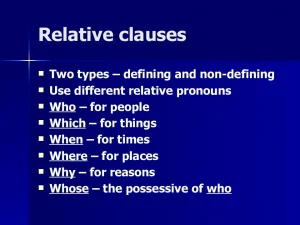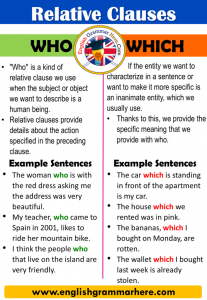Hello,dear students.Please watch this video below and make some notes and you should do the exercise.
На данном уроке мы поговорим об относительных придаточных предложениях – Relative clauses. В ходе занятия мы узнаем, какие местоимения и наречия используются в предложениях данного типа, в чем состоит различие между ними, а также в каких случаях можно опускать относительные местоимения.
 Relative clauses – это определительные придаточные предложения, которые начинаются с относительных местоимений (relative pronouns) или относительных наречий (relative adverbs) (рис. 1, 2): who/that/which – который whose – которого when – когда where – где why – почему We can use relative clauses to join two sentences or to give more information about something. We use relative clauses to describe people, things, time, places or reasons. Relative pronoun comes after the noun it describes. Пример: The boy who won the prize was happy. Those jeans which you want to buy are really expensive. Видеоурок Текстовый урок Тренажеры Тесты Вопросы На данном уроке мы поговорим об относительных придаточных предложениях – Relative clauses. В ходе занятия мы узнаем, какие местоимения и наречия используются в предложениях данного типа, в чем состоит различие между ними, а также в каких случаях можно опускать относительные местоимения. Общая информация о Relative Clauses Relative clauses – это определительные придаточные предложения, которые начинаются с относительных местоимений (relative pronouns) или относительных наречий (relative adverbs) (рис. 1, 2): who/that/which – который whose – которого when – когда where – где why – почему Рис. 1. Relative clauses (Источник) We can use relative clauses to join two sentences or to give more information about something. We use relative clauses to describe people, things, time, places or reasons. Relative pronoun comes after the noun it describes. Пример: The boy who won the prize was happy. Those jeans which you want to buy are really expensive. Рис. 2. Relative pronouns and adverbs (Источник) Relative clauses can be identifying (ограничительные) or non-identifying (распространительные). Identifying clauses give essential information. The sentence will not be complete without them. Non-identifying clauses are more often used in written English than in spoken English. They give extrai nformation we do not usually need to understand the sense of the sentence. They usually go between commas. Non-identifying relative clauses can use most relative pronouns but they can’t use ‘that’. Identifying relative clause: выражает важную информацию; без него предложение не завершено по смыслу. Пример: This is the new car that I bought yesterday. – Это новая машина, которую я купил вчера. The ring which he bought for her is beautiful. – Кольцо, которое он купил для нее, прекрасно. The book that you see on the table cost me twenty pounds. – Книга, которую ты видишь на столе, стоила мне двадцать фунтов. Рис. 3. Relative clauses (Источник) Non-identify ingrelative clause: выражает дополнительную информацию, без которой можно обойтись; отделяется запятыми в предложении; не используется с that. Пример: The school, where I studied, is in the centre of the city. – Школа, где я учился, в центре города. The textbooks, which the students like, have lots of helpful examples. – В учебниках, которые нравятся студентам, очень много полезных примеров. John, who plays football, is always busy at weekends. – Джон, который играет в футбол, очень занят на выходных. Relative pronouns as subject and object Relative pronouns can be either a subject or an object in relative clauses. When a relative pronoun is a subject, it is followed by a verb. When it is an object, it is followed by a noun or a pronoun. Пример: Subject Object Do you know the man who talked to me? The peaches that are lying on the table are tasty. We will stay at a hotel which is next to the beach. That is the film which is very exciting. Do you know the man who I talked to? The peaches that you bought in the shop are tasty. We will stay at a hotel which my friend has recommended to us. That is the film which I like very much.
Relative clauses – это определительные придаточные предложения, которые начинаются с относительных местоимений (relative pronouns) или относительных наречий (relative adverbs) (рис. 1, 2): who/that/which – который whose – которого when – когда where – где why – почему We can use relative clauses to join two sentences or to give more information about something. We use relative clauses to describe people, things, time, places or reasons. Relative pronoun comes after the noun it describes. Пример: The boy who won the prize was happy. Those jeans which you want to buy are really expensive. Видеоурок Текстовый урок Тренажеры Тесты Вопросы На данном уроке мы поговорим об относительных придаточных предложениях – Relative clauses. В ходе занятия мы узнаем, какие местоимения и наречия используются в предложениях данного типа, в чем состоит различие между ними, а также в каких случаях можно опускать относительные местоимения. Общая информация о Relative Clauses Relative clauses – это определительные придаточные предложения, которые начинаются с относительных местоимений (relative pronouns) или относительных наречий (relative adverbs) (рис. 1, 2): who/that/which – который whose – которого when – когда where – где why – почему Рис. 1. Relative clauses (Источник) We can use relative clauses to join two sentences or to give more information about something. We use relative clauses to describe people, things, time, places or reasons. Relative pronoun comes after the noun it describes. Пример: The boy who won the prize was happy. Those jeans which you want to buy are really expensive. Рис. 2. Relative pronouns and adverbs (Источник) Relative clauses can be identifying (ограничительные) or non-identifying (распространительные). Identifying clauses give essential information. The sentence will not be complete without them. Non-identifying clauses are more often used in written English than in spoken English. They give extrai nformation we do not usually need to understand the sense of the sentence. They usually go between commas. Non-identifying relative clauses can use most relative pronouns but they can’t use ‘that’. Identifying relative clause: выражает важную информацию; без него предложение не завершено по смыслу. Пример: This is the new car that I bought yesterday. – Это новая машина, которую я купил вчера. The ring which he bought for her is beautiful. – Кольцо, которое он купил для нее, прекрасно. The book that you see on the table cost me twenty pounds. – Книга, которую ты видишь на столе, стоила мне двадцать фунтов. Рис. 3. Relative clauses (Источник) Non-identify ingrelative clause: выражает дополнительную информацию, без которой можно обойтись; отделяется запятыми в предложении; не используется с that. Пример: The school, where I studied, is in the centre of the city. – Школа, где я учился, в центре города. The textbooks, which the students like, have lots of helpful examples. – В учебниках, которые нравятся студентам, очень много полезных примеров. John, who plays football, is always busy at weekends. – Джон, который играет в футбол, очень занят на выходных. Relative pronouns as subject and object Relative pronouns can be either a subject or an object in relative clauses. When a relative pronoun is a subject, it is followed by a verb. When it is an object, it is followed by a noun or a pronoun. Пример: Subject Object Do you know the man who talked to me? The peaches that are lying on the table are tasty. We will stay at a hotel which is next to the beach. That is the film which is very exciting. Do you know the man who I talked to? The peaches that you bought in the shop are tasty. We will stay at a hotel which my friend has recommended to us. That is the film which I like very much.
Проверьте знания с помощью теста